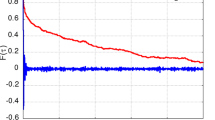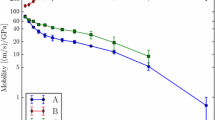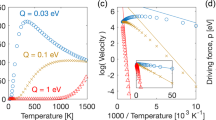Abstract
A molecular-dynamics method for the simulation of the intrinsicmigration behavior of individual, flat grain boundaries is introducedand validated. A constant driving force for grain-boundary migrationis generated by imposing an anisotropic elastic strain on a bicrystalsuch that the elastic-energy densities in its two halves aredifferent. For the model case of a large-planar-unit-cell, high-angle(001) twist boundary in Cu we show that an elastic strain of∼1%–4% is sufficient to drive thecontinuous, viscous movement of the boundary at temperatures wellbelow the melting point. The driving forces thus generated (at thehigh end of the experimentally accessible range) enable aquantitative evaluation of the migration process during the timeframe of 10-9 s typically accessible bymolecular-dynamics simulation. For this model high-angle grainboundary we demonstrate that (a) the drift velocity is, indeed,proportional to the applied driving force thus enabling us todetermine the boundary mobility, (b) the activation energy forgrain-boundary migration is distinctly lower than that forgrain-boundary self-diffusion or even self-diffusion in the melt and(c) in agreement with earlier simulations the migration mechanisminvolves the collective reshuffling during local disordering(“melting”) of small groups of atoms and subsequentresolidification onto the other crystal.
Similar content being viewed by others
References
See, for example, F.S. Humphreys and N. Hatherly, Recrystallization and Related Annealing Phenomena(Pergamon, 1995).
K.T. Aust and J.W. Rutter, in Recovery and Recrystallization of Metals, edited by L. Himmel (AIME, Interscience Publishers, New York, 1963), p. 131.
K. Lücke and H.-P. Stü we, in Recovery and Recrystallization of Metals, edited by L. Himmel (AIME, Interscience Publishers, New York, 1963), p. 171.
R. Viswanathan and C.L. Bauer, Acta Metall. 21, 1099 (1973).
S.E. Babcock and R.W. Balluffi, Acta Metall. 37, 2357 and 2367 (1989).
G. Gottstein and L.S. Shvindlerman, Scripta Metall. Mater. 27, 1521 (1992).
N.F. Mott, Proc. Phys. Soc. 60, 391 (1948).
D. Turnbull, Trans. AIME 191, 661 (1951).
D.A. Smith, C.M.F. Rae, and C.R.M. Grovenor, in Grain Boundary Structure and Kinetics, edited by R.W. Balluffi (ASM, Metals Park, Ohio, 1980), p. 337.
R. Jhan and P.D. Bristowe, Scripta Metall. Mater. 24, 1313 (1990).
A.P. Sutton, in Computer Simulation of Materials Science: Nano/Meso/Macroscopic Space and Time Scales, edited by H.O. Kirchner, L.P. Kubin, and V. Pontikis (NATO-ASI Series E, 1996), Vol. 308, pp. 163–187.
J.M. Rickman, S.R. Phillpot, D. Wolf, D.L. Woodraska, and S. Yip, J.Mater. Res. 6, 2291 (1991).
See, for example, D. Wolf, in Materials Interfaces: Atomic-level Structure and Properties, edited by D. Wolf and S. Yip (Chapman & Hall, London, 1992), Chap. 1, p. 1.
J.F. Nye, Physical Properties of Crystals(Clarendon Press, Oxford, 1957).
M. Parrinello and A. Rahman, J. Appl. Phys. 52, 7182 (1981).
C.L. Bauer, J. Phys. (Paris), Colloque 43, C6–187 (1982).
S.R. Phillpot and J.M. Rickman, J. Chem. Phys. 94, 1454 (1991).
D. Wolf, J.F. Lutsko, and M. Kluge, in Atomistic Simulations of Materials-Beyond Pair Potentials, edited by V. Vitek and D. Srolovitz (Plenum Press, 1989), p. 245.
D. Wolf and K.L. Merkle, in Materials Interfaces: Atomic-level Structure and Properties, edited by D. Wolf and S. Yip (Chapman & Hall, London, 1992), Chap. 3, p. 87.
J.F. Lutsko, D. Wolf, S. Yip, S.R. Phillpot, and T. Nguyen, Phys. Rev. B 38, 11572 (1988).
J.M. Rickman and S.R. Phillpot, Phys. Rev. Letters 66, 349 (1991).
M.S. Daw and M.I. Baskes, Phys. Rev. B 29, 6443 (1986).
M.W. Finnis and J.E. Sinclair, Philos. Mag. A 50, 45 (1984).
J.A. Jaszczak and D. Wolf, Phys. Rev. B 46, 2473 (1992).
D. Wolf, Acta Metall. 37, 1983 (1989).
R.W. Balluffi, J. Nucl. Mats. 69 & 70, 240 (1978).
P. Keblinski, Private Communication (1996).
J. Henderson and L. Yang, Trans. Met. Soc. AIME 72, 221 (1971).
W.T. Read and W. Shockley, Phys. Rev. 78, 275 (1950).
W. In der Schmitten, P. Haasen, and F. Haessner, Z. Metallk. 51, 101 (1960).
CRC Materials Science and Engineering Handbook, edited by J.F. Shackelford (CRC Press, 1994), p. S–64.
See also A.P. Sutton and R.W. Balluffi, Interfaces in Crystalline Materials(Oxford, 1995), p. 550ff.
Author information
Authors and Affiliations
Rights and permissions
About this article
Cite this article
Schönfelder, B., Wolf, D., Phillpot, S. et al. Molecular-Dynamics Method for the Simulation of Grain-Boundary Migration. Interface Science 5, 245–262 (1997). https://doi.org/10.1023/A:1008663804495
Issue Date:
DOI: https://doi.org/10.1023/A:1008663804495




